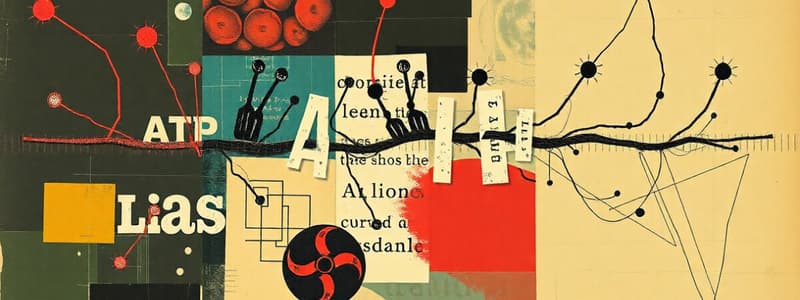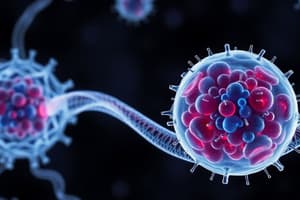Podcast
Questions and Answers
What is the main function of metabolism in a cell?
What is the main function of metabolism in a cell?
- To transport waste out of the cell
- To build up and break down nutrients (correct)
- To protect the cell from external threats
- To maintain the cell's structure
Which of the following describes catabolism?
Which of the following describes catabolism?
- Breaking down complex molecules (correct)
- Transporting molecules
- Duplicating cell structures
- Building complex molecules
Anabolic reactions are:
Anabolic reactions are:
- Endergonic (correct)
- Isotonic
- Anergonic
- Exergonic
What determines metabolic pathways?
What determines metabolic pathways?
What encodes enzymes?
What encodes enzymes?
What is activation energy?
What is activation energy?
What do enzymes do to the activation energy of a reaction?
What do enzymes do to the activation energy of a reaction?
What is the function of a catalyst?
What is the function of a catalyst?
What is formed when a substrate contacts an enzyme's active site?
What is formed when a substrate contacts an enzyme's active site?
What happens to the enzyme after it reacts with a substrate?
What happens to the enzyme after it reacts with a substrate?
What does the turnover number of an enzyme represent?
What does the turnover number of an enzyme represent?
Enzyme names typically end in which suffix?
Enzyme names typically end in which suffix?
What type of reaction does an oxidoreductase catalyze?
What type of reaction does an oxidoreductase catalyze?
Which enzyme is responsible for transferring functional groups?
Which enzyme is responsible for transferring functional groups?
Which environmental factor does NOT influence enzyme activity?
Which environmental factor does NOT influence enzyme activity?
What happens to an enzyme at high temperatures?
What happens to an enzyme at high temperatures?
What is the effect of extreme pH levels on enzymes?
What is the effect of extreme pH levels on enzymes?
What happens to an enzyme's activity when the substrate concentration is very high?
What happens to an enzyme's activity when the substrate concentration is very high?
What happens to the rate of reaction as substrate concentration increases, up to a certain point?
What happens to the rate of reaction as substrate concentration increases, up to a certain point?
What do competitive inhibitors do?
What do competitive inhibitors do?
Where do noncompetitive inhibitors interact with an enzyme?
Where do noncompetitive inhibitors interact with an enzyme?
What is the process of noncompetitive inhibition also known as?
What is the process of noncompetitive inhibition also known as?
In feedback inhibition, what inhibits enzymes from earlier in the pathway?
In feedback inhibition, what inhibits enzymes from earlier in the pathway?
What molecule is a ribozyme made of?
What molecule is a ribozyme made of?
What is the function of ribozymes?
What is the function of ribozymes?
What site on the enzyme does a competitive inhibitor bind to?
What site on the enzyme does a competitive inhibitor bind to?
What eventually happens to the rate of reaction when the active sites of all enzyme molecules are filled?
What eventually happens to the rate of reaction when the active sites of all enzyme molecules are filled?
What is the allosteric site?
What is the allosteric site?
What is the relationship between catabolic and anabolic reactions in metabolism?
What is the relationship between catabolic and anabolic reactions in metabolism?
What is the role of enzymes within metabolic pathways?
What is the role of enzymes within metabolic pathways?
According to the collision theory, what is required for a chemical reaction to occur?
According to the collision theory, what is required for a chemical reaction to occur?
How do enzymes affect the rate of chemical reactions?
How do enzymes affect the rate of chemical reactions?
What is the term for the energy needed for a chemical reaction to occur?
What is the term for the energy needed for a chemical reaction to occur?
What is the primary effect of a catalyst on a chemical reaction?
What is the primary effect of a catalyst on a chemical reaction?
What determines the specific sequence of a metabolic pathway?
What determines the specific sequence of a metabolic pathway?
What occurs when the substrate concentration increases and the active sites on all enzyme molecules are filled?
What occurs when the substrate concentration increases and the active sites on all enzyme molecules are filled?
What do competitive inhibitors compete with for binding?
What do competitive inhibitors compete with for binding?
Where on the enzyme does a noncompetitive inhibitor typically bind?
Where on the enzyme does a noncompetitive inhibitor typically bind?
What is the result of feedback inhibition?
What is the result of feedback inhibition?
What type of molecule is a ribozyme?
What type of molecule is a ribozyme?
What is formed when a substrate binds to an enzyme?
What is formed when a substrate binds to an enzyme?
What happens to an enzyme after it catalyzes a reaction?
What happens to an enzyme after it catalyzes a reaction?
What does the turnover number of an enzyme indicate?
What does the turnover number of an enzyme indicate?
Which of the following is NOT a factor that influences enzyme activity?
Which of the following is NOT a factor that influences enzyme activity?
What can happen to enzymes at high temperatures?
What can happen to enzymes at high temperatures?
Saturation occurs when:
Saturation occurs when:
Flashcards
Metabolism
Metabolism
The buildup and breakdown of nutrients in a cell, providing energy.
Catabolism
Catabolism
The process that breaks down complex molecules to provide energy and building blocks.
Anabolism
Anabolism
The process that builds complex molecules using energy and building blocks.
Metabolic Pathways
Metabolic Pathways
Signup and view all the flashcards
Enzymes
Enzymes
Signup and view all the flashcards
Activation Energy
Activation Energy
Signup and view all the flashcards
Collision Theory
Collision Theory
Signup and view all the flashcards
Exergonic Reactions
Exergonic Reactions
Signup and view all the flashcards
Endergonic Reactions
Endergonic Reactions
Signup and view all the flashcards
Substrate
Substrate
Signup and view all the flashcards
Enzyme-Substrate Complex
Enzyme-Substrate Complex
Signup and view all the flashcards
Turnover Number
Turnover Number
Signup and view all the flashcards
Enzyme Specificity
Enzyme Specificity
Signup and view all the flashcards
Denaturation
Denaturation
Signup and view all the flashcards
Factors Affecting Enzyme Activity
Factors Affecting Enzyme Activity
Signup and view all the flashcards
Naming Enzymes
Naming Enzymes
Signup and view all the flashcards
Oxidoreductase
Oxidoreductase
Signup and view all the flashcards
Hydrolase
Hydrolase
Signup and view all the flashcards
Enzyme Saturation
Enzyme Saturation
Signup and view all the flashcards
Inhibitors
Inhibitors
Signup and view all the flashcards
Substrate Concentration
Substrate Concentration
Signup and view all the flashcards
Maximum Reaction Rate
Maximum Reaction Rate
Signup and view all the flashcards
Competitive Inhibitors
Competitive Inhibitors
Signup and view all the flashcards
Noncompetitive Inhibitors
Noncompetitive Inhibitors
Signup and view all the flashcards
Allosteric Inhibition
Allosteric Inhibition
Signup and view all the flashcards
Feedback Inhibition
Feedback Inhibition
Signup and view all the flashcards
Ribozymes
Ribozymes
Signup and view all the flashcards
Active Site
Active Site
Signup and view all the flashcards
Allosteric Site
Allosteric Site
Signup and view all the flashcards
Enzyme Activity
Enzyme Activity
Signup and view all the flashcards
Catabolic Reactions
Catabolic Reactions
Signup and view all the flashcards
Anabolic Reactions
Anabolic Reactions
Signup and view all the flashcards
Enzymatic Catalysis
Enzymatic Catalysis
Signup and view all the flashcards
Factors Influencing Enzyme Activity
Factors Influencing Enzyme Activity
Signup and view all the flashcards
Study Notes
Microbial Metabolism
- Metabolism is the buildup and breakdown of nutrients within a cell.
- Chemical reactions provide energy and create substances that sustain life.
- Microbial metabolism can cause disease and food spoilage, but many pathways are beneficial.
- Drugs, such as antibiotics, and other treatments are derived from microbial metabolism.
Dental Plaque
- Dental plaque consists of bacteria.
Catabolic and Anabolic Reactions
- Catabolism breaks down complex molecules, provides energy and building blocks for anabolism; exergonic.
- Anabolism uses energy and building blocks to build complex molecules; endergonic.
- Catabolic and anabolic pathways are linked by energy; catabolic reactions provide energy needed for anabolic reactions.
- ATP is used by microbes and other cells to manage energy needs. Catabolic reactions couple with ATP synthesis. Anabolic reactions couple with ATP breakdown.
- Metabolic pathways are sequences of enzymatically catalyzed chemical reactions in a cell.
- Metabolic pathways are determined by enzymes.
- Enzymes are encoded by genes.
Collision Theory
- Chemical reactions occur when atoms, ions, and molecules collide.
- Activation energy is the collision energy required for a chemical reaction to occur.
- Reaction rate is the frequency of collisions containing enough energy to bring about a reaction.
- Reaction rate can be increased by enzymes or by increasing temperature, pressure, or concentration.
Enzymes and Chemical Reactions
- Catalysts speed up chemical reactions without being altered.
- Enzymes are biological catalysts.
- Enzymes act on a specific substrate and lower the activation energy.
- Substrate contacts the enzyme's active site to form an enzyme-substrate complex.
- Substrate is transformed and rearranged into products, which are released from the enzyme.
- Enzyme is unchanged and can react with other substrates.
Enzyme Specificity and Efficiency
- Enzymes have specificity for particular substrates.
- Turnover number is the number of substrate molecules an enzyme converts to a product per second.
- Generally, it is 1 to 10,000.
Naming Enzymes
- Names of enzymes usually end in -ase; grouped based on the reaction they catalyze.
- Oxidoreductase: oxidation-reduction reactions.
- Transferase: transfer functional groups.
- Hydrolase: hydrolysis.
- Lyase: removal of atoms without hydrolysis.
- Isomerase: rearrangement of atoms.
- Ligase: joining of molecules; uses ATP.
Holoenzyme
- An apoenzyme, the inactive protein portion, combined with a cofactor (nonprotein portion) or coenzyme creates a holoenzyme, the active form.
Factors Influencing Enzyme Activity
- Temperature: high temperatures denature proteins
- pH: extreme pH denatures proteins
- Substrate concentration: high substrate concentrations lead to maximum reaction rates, saturation.
- Inhibitors: (see inhibitors section)
Inhibitors
- Competitive inhibitors fill the active site of an enzyme and compete with the substrate (examples include sulfanilamide and PABA).
- Noncompetitive inhibitors interact with another part of the enzyme (allosteric site) rather than the active site in a process called allosteric inhibition.
Feedback Inhibition
- End-product of a reaction allosterically inhibits enzymes from earlier in the pathway.
Ribozymes
- RNA that function as catalysts by cutting and splicing RNA.
Studying That Suits You
Use AI to generate personalized quizzes and flashcards to suit your learning preferences.



